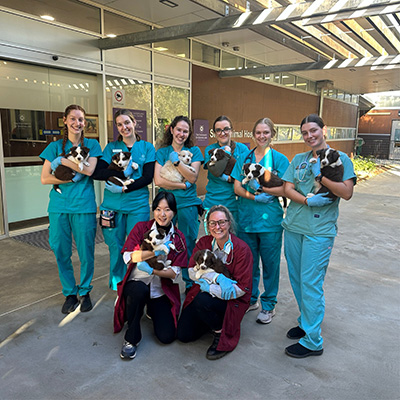 For thousands of veterinary science students, the fifth and final year of their program is one of excitement and trepidation. Its mandatory placement requirement marks their first career steps. Now, away from the comfort of classroom, teachers and, sometimes home, they’ll work 40-hour weeks learning full-time at the side of experienced vets.
For thousands of veterinary science students, the fifth and final year of their program is one of excitement and trepidation. Its mandatory placement requirement marks their first career steps. Now, away from the comfort of classroom, teachers and, sometimes home, they’ll work 40-hour weeks learning full-time at the side of experienced vets.
What could be better, you ask? And in many ways, you’d be right. Out of the classroom and into the field, they see all that they’ve been learning come to life - and then some. They get those ‘aha’ moments that only immersive experience can bring, eagerly making mental notes and committing tips to memory.
Of course, it’s not all sunshine and roses. They’re still students, after all, and there’s a lot they don’t know. That’s why they’re there. They’ve got to be on their toes, focused. Financial worries are neither helpful, nor productive. Imagine, after one of those exhausting days, checking your bank account to see whether you can afford a quality take-away dinner on your way home. Groceries, rent, transport – it all adds up and, with the rising cost of living, the tab is running higher than ever before.
For veterinary students, this is the reality of their final year of study, their last push to the finish line where a hard-earned reward awaits. Leaving now would mean dashed dreams, a career interrupted, debt and disappointment. They’ve come a long way by 5th year and they’re almost there.
Student placements are vital in the veterinary practice journey, whether these are taken up in the city or in country towns. To register and practice as a veterinarian, the Australasian Veterinary Boards Council (AVBC) requires that students complete at least 52 weeks of placement before graduation. Sadly for many, placement poverty is real and can be heightened for students who take on practicums far from home. In fact, financial pressures may prevent students from doing rural and regional placements or looking beyond where they already live for practicum opportunities.
The implications are several. First, student exposure to the wide-ranging career possibilities open to them is curtailed. Second, they are less likely to push themselves and their learning beyond their comfort zone or to follow their curiosity. Third, regional communities lose out.
The shortage of vets across Australia is no secret and perhaps nowhere is this felt more acutely than in country towns. Over and above the benefit of having uni students in rural and regional communities, it is widely held that at least some of those students will settle and practice there once they’ve had a taste of the life on offer.
Professor Nigel Perkins, Head of UQ’s School of Veterinary Science says, “Often students are having to travel further afield for rural and regional placements or placements in large animal practises. That may mean that they are forced to make decisions about placements that may not involve going to a place that they really want to go because it's too far away and the costs are too high. That then has potentially long-lasting impacts on their sense of wellbeing, career satisfaction and activities after graduation.”
Professor Perkin’s vision is for every final-year vet student to receive financial support to undertake both urban and rural placements, including large animal practicums. Achieving this goal will require approximately $350,000 each year, over and above support already provided to students by the University and the School.
If you’d like to help open doors to worry-free, enriched and expanded placement experiences for UQ veterinary students, please click here or reach out to Marlin Othman for a confidential conversation.



